Simply incredible.
These are the words that pop to mind as I stare down four massive columns, inscribed from top to bottom with rows of ancient Egyptian hieroglyphics. Even in an era of on-demand everything and digital overload, these ancient Egyptian writings (and the monumental temples and artifacts that go with them) continue to captivate.
Long fascinated by the ancient civilization’s mysterious culture, I was ecstatic when I discovered the opportunity to experience everything from pharaohs to temples right in my own backyard. For Seattleites like myself, a quick ride up to Victoria, BC on the Victoria Clipper V leads you right to the North American debut of Egypt: The Time of Pharaohs at the Royal BC Museum.
Co-created by Dr. Christian Tietze from Weimar and Dr. Christian Bayer from the Pelizaeus-Museum, the one-of-a-kind exhibit features more than 350 priceless ancient artifacts offering a glimpse into the lives of everyday Egyptians. The Royal BC Museum’s Head of Learning, Janet MacDonald says,
“One of the main differences between this exhibit and Eternal Egypt in 2004 is the work was found in temples instead of tombs and isn’t just about pharaonic Egypt.” She adds, “The exhibit makes everyday life in Egypt personal, so visitors can feel a connection.”
Curiosity piqued by the images on columns and interested in rekindling what I had learned in school, I first walk past the massive columns (inside tip: in case you were wondering, the hieroglyphics roughly translate to “Welcome to the treasure house of victory,” a nod to the city of Victoria and the museum itself) before coming to a second, pyramid-like gateway.
With faux stone blocks, flickering candles and a narrow passageway, the confined space makes me I feel as though I am creeping through an actual pyramid. Even little ones are included in the experience, with their own kid-sized doorway and window that offers a sneak peek at a few of the artifacts.
1. Get a Peek at Life Along the Nile
Entering the exhibit, my eyes are immediately drawn to the large multimedia screens displaying an expansive desert scene with a ribbon of water rippling through it. What better way to introduce this ancient civilization than showing us its birthplace on the banks of the Nile? MacDonald explains, “Water is the source of any rise of civilization, so it made sense to start with this vital artery.”
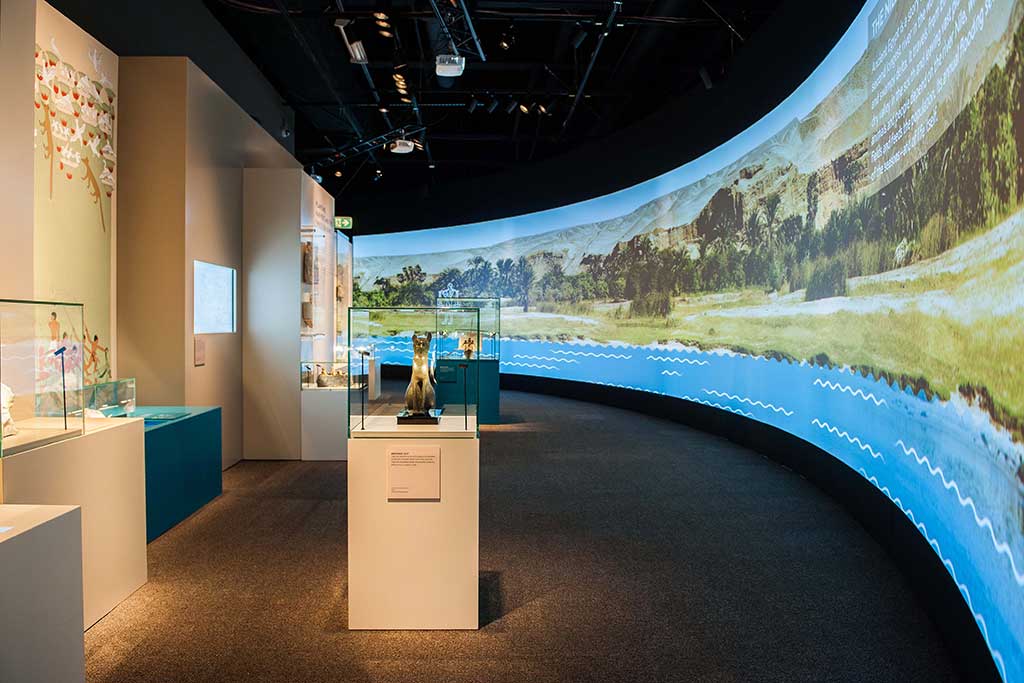
I make my way toward a cluster of small, excited kiddos, joining in to peer at a row of intricately carved animals, conveniently placed at their eye level. Smiles aglow across the group, the assortment of shrews, hippos, crocodiles and more are one of the sure-fire winners of the exhibit.
MacDonald says, “One of the must-sees of the section is the bronze cat. These felines were seen as gentle and peaceful creatures and essential to Egyptian households. This sculpture is particularly unique due to its size, as it is much larger than other sculptures created in this material.”
2. Walk Among Egyptian Gods
The light slowly shifts from light to dark as I transition into the spiritual realm of the gods. I stroll past an incredible lineup of artifacts. MacDonald notes, “Some of my favorite items were not found in the pharaoh’s tombs, but instead in village shrines, workshops and temples.” These gods for the living were mostly protective deities. The powerful Thoeris and Bes, were worshiped for their powers to help pregnant women, Isis and Hathor were considered the mother goddesses, and Bastet, the goddess of love.
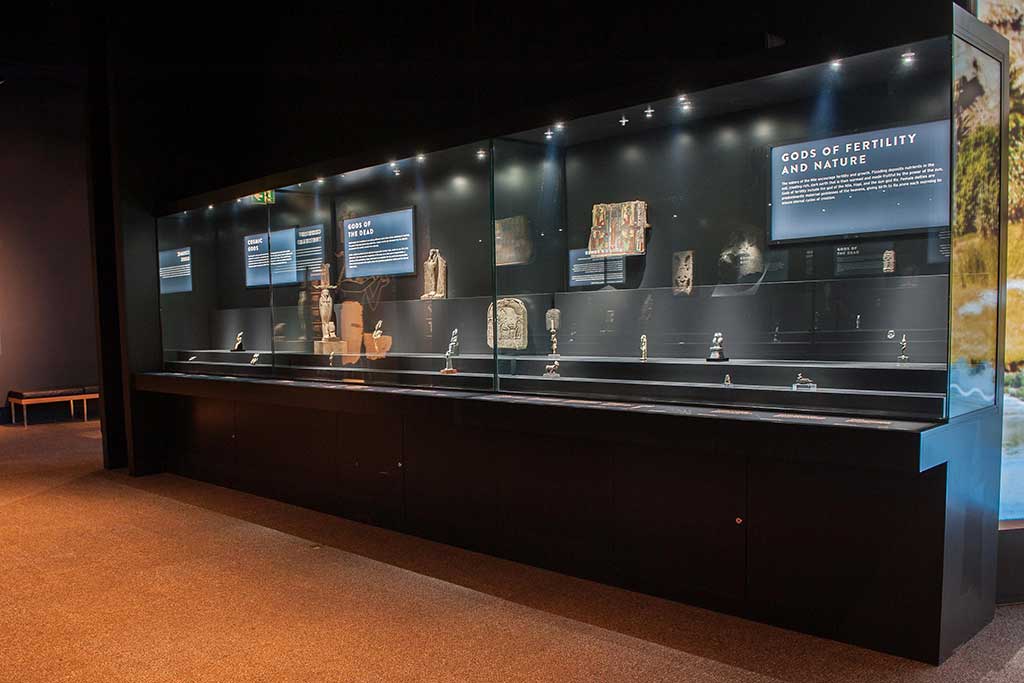
MacDonald tells me, “If I had to pick a favorite piece from the entire exhibit, it would be the demi-god Bes, the protector of pregnant women. The piece has a very unusual look that is almost ferocious. The fact that it is a wood-carved statue also makes it very different from many of the sculptures in the exhibit.”
3. Meet Six of Egypt’s Extraordinary Pharaohs
After spending time with the deities of the heavens, it’s time to meet the gods on earth. While Egypt was ruled by more than 170 pharaohs, the exhibit highlights six leaders, Ramesses II, Khufu, Amenhotep III, Thutmose III, Akhenaten and Hatshepsut. According to MacDonald, “They were chosen for their name recognition and strong personalities.”
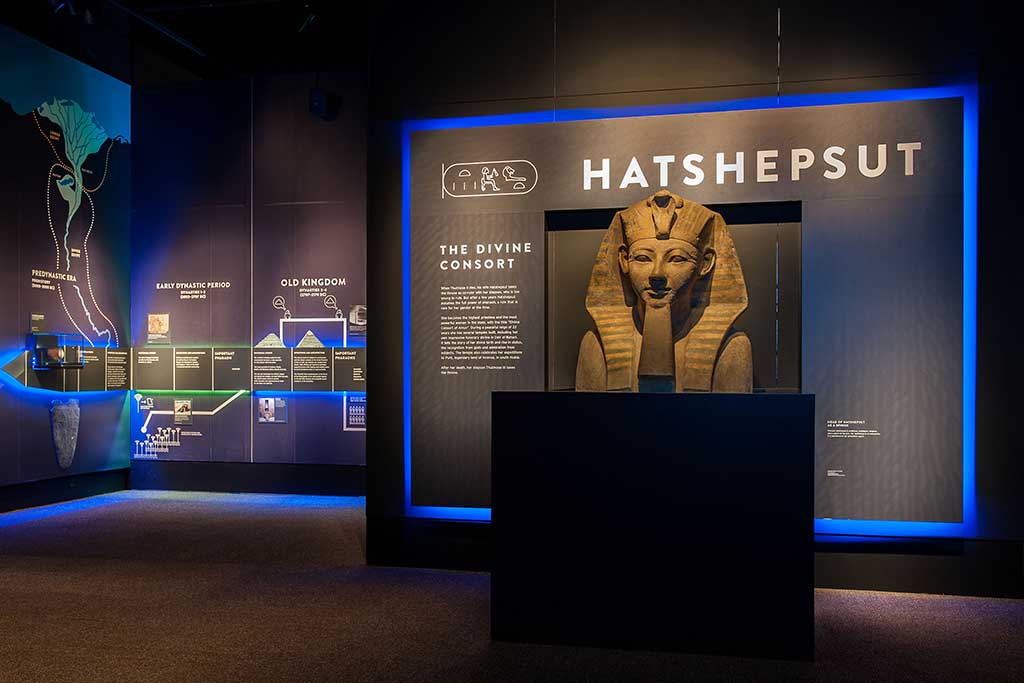
Each pharaoh has their own panel that allows the extraordinary stories of the individual rulers to emerge. Don’t miss the section devoted to Hatshepsut. A unique find, MacDonald explains that, “The bust of Hatshepsut is especially incredible, as it retains a lot of the original paint pigments. The sculpture is also rare, since many depictions of her were destroyed during the reign of her step-son Thutmose III.”
4. See Where the Gods Lived
The ancient Egyptians liked to do things on a LARGE scale. Think pyramids and the Sphinx. Their temples are no exception. For a glimpse at what everyday life was like inside these spaces, I swing by the collection of carefully-crafted wooden models built by curators of the exhibit in Germany.
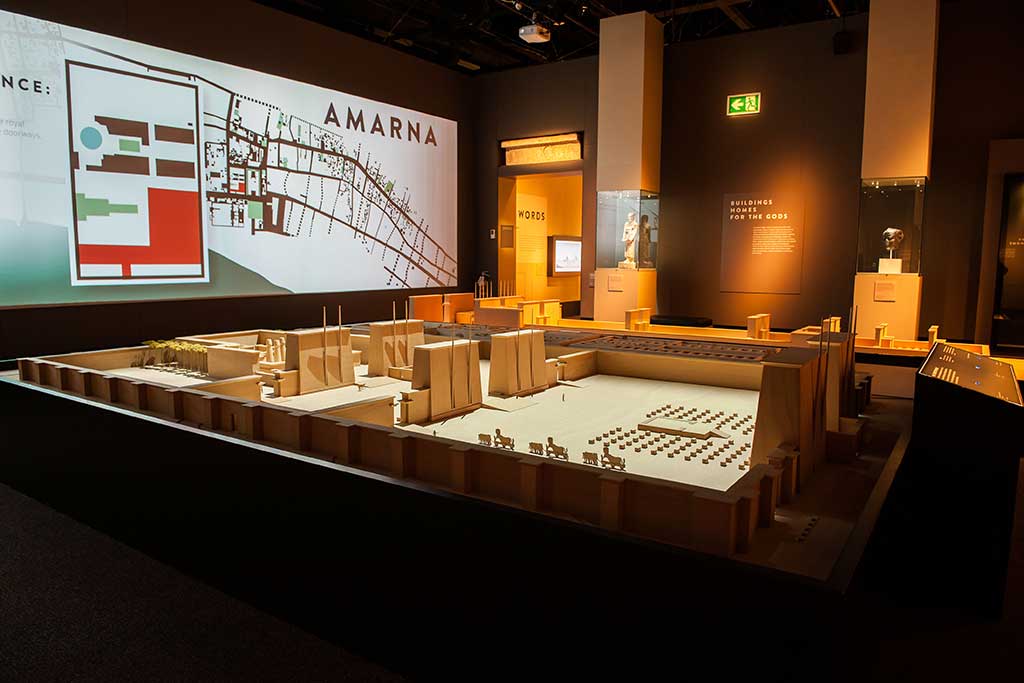
A dazzling display of white, yellow and blue lights illuminates the path of a religious ceremony that would have been performed in the temple. I leave with a new appreciation these sacred places as well as the activities that took place inside.
5. Learn How Writing Defined a Nation
Much of ancient Egypt’s religion and civilization would remain a mystery without a written history. I peek at tablets and even wine jugs inscribed with elaborate rows of hieroglyphics. It is hard to believe what looks like a stone etching to the untrained eye may actually be something similar to my weekly grocery receipt.
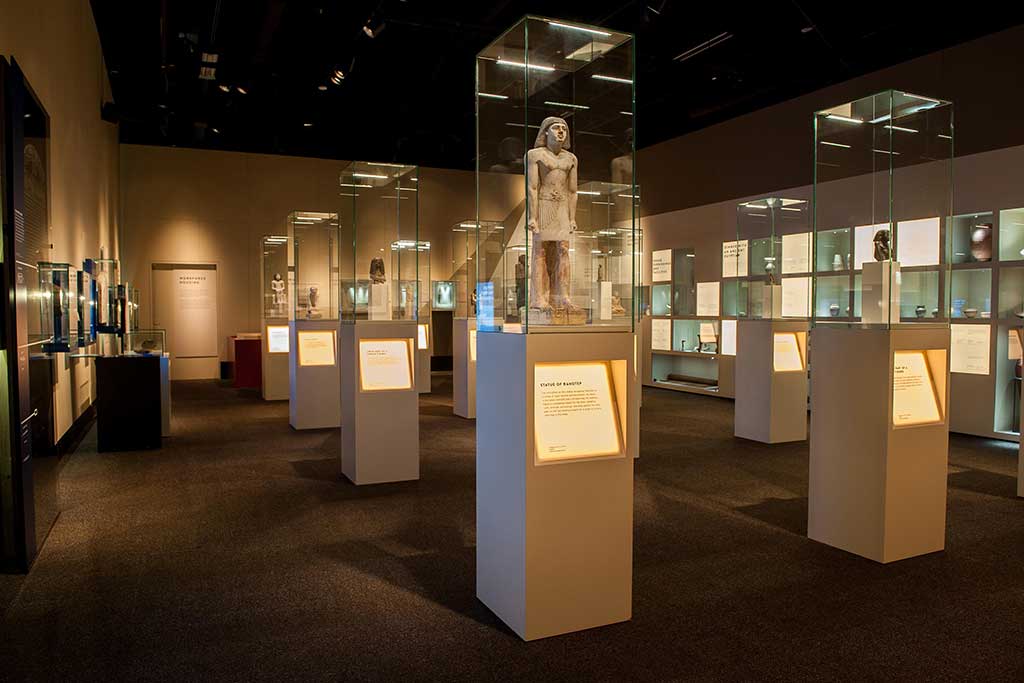
Eager to try my hand at penning a few letters myself, I tuck into the interactive drawing station. In a few swift strokes, I am able to craft a blocky owl on the screen before me. However, I am happy I opted for the medium level of difficulty, as sketching a single figure is tougher than it looks but still a fantastic interactive component of the exhibition for kids and adults alike to check out.
6. Explore Egypt’s Cult of Beauty
If there’s one thing that hasn’t changed in the last 4,500 years, it is women’s desire for beauty. An irresistible array of stunning bracelets, necklaces and collars stretch along the corridor. One of the standout pieces is a glittering, braided golden collar. MacDonald says that it is incredible that 19 of the 20 original ornate pomegranate pendants remain intact.
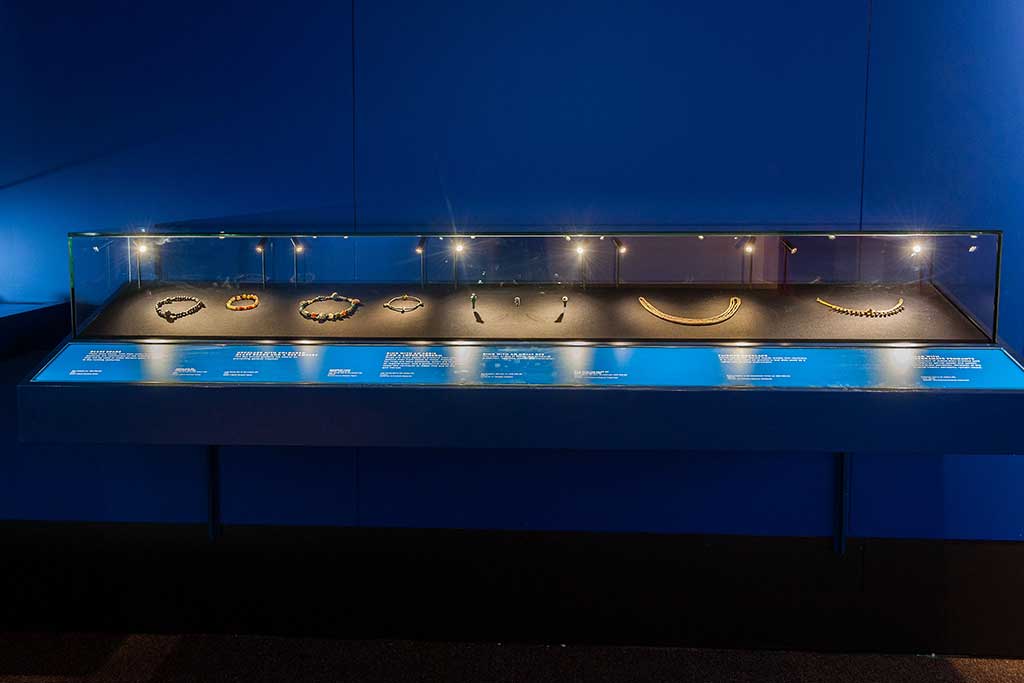
Only a few feet away, a wall brims with translucent, stone cosmetic pots and ointment jars, and I can only imagine what lotions, powders and oils were kept inside. MacDonald points out a row of tiny tweezers, each no more than half of an inch long. While they vary vastly in size, MacDonald notes they really are not too different from modern-day styles, stating, “It is a great reminder of how the more things change, the more they stay the same.”
7. Discover Egypt’s Intriguing Burial Practices & Afterlife
Strolling through a dark, dimly lit passageway that feels like traveling down a telescoping tunnel into the afterlife (yes, it was intentionally designed that way). At the end of the passage, I’m greeted with a sheet of papyrus from the book of the dead, which portrays how a person’s heart and soul were weighed against justice to determine if they can withstand the journey to the afterlife.
Curious where I’d stack up, I pop in line for a chance to test my fate against the Royal BC Museum’s own interactive judgment of the dead. Much like the book of the dead, the game features a series of multiple choice questions. Answer too many wrong and you are likely to end up in the jaws of a fearsome beast called Ammit, the “soul eater.” I carefully consider my answers and luckily my spirit qualifies for the trip to the afterlife.
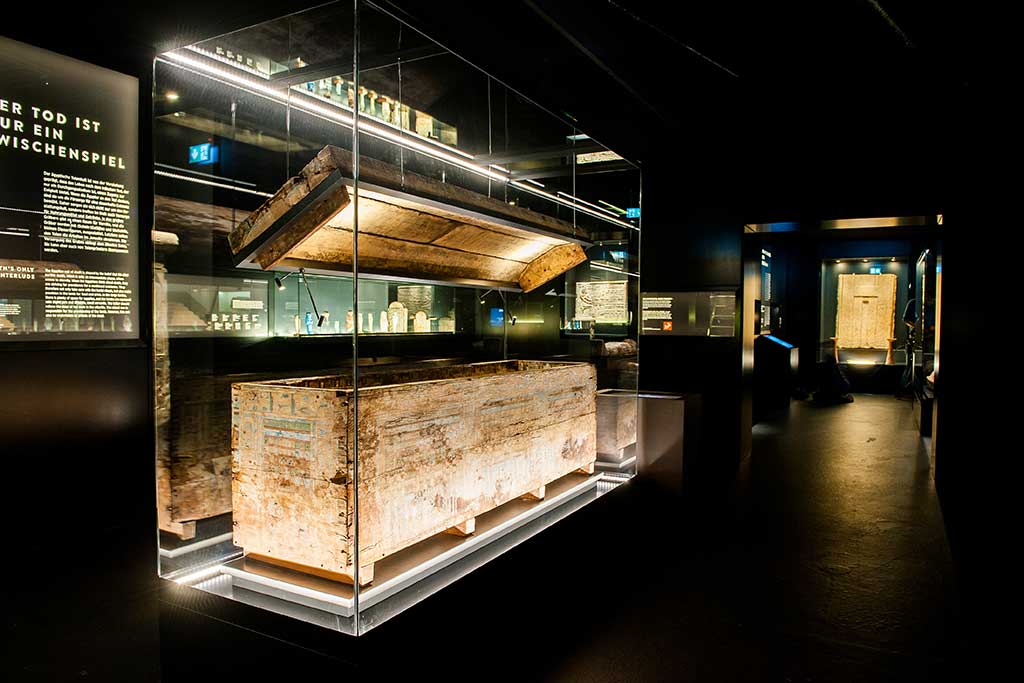
I explore the subsequent gallery and find it chock-full of well-preserved objects. Not wanting to miss anything, I soak in every last detail from the beautiful false door of Ankh, to delicate protective amulets and grave goods and the vibrant coffins for the Overseer of the Granary Nakht Middle Kingdo, the coffin of the Official Pa-ser, as well as the lid from the Inner Coffin of Ta-Khar.
While I could already easily leave with a list of top-picks more than a mile long, MacDonald mentions one last favorite piece found in this area of the exhibit, a replica of a tomb from the Valley of the Kings. She recommends, “Wait till a quiet moment and lay down on the bench in the center. The space is the actual size of a tomb, so it gives you an idea of what it would feel like to be inside one.”
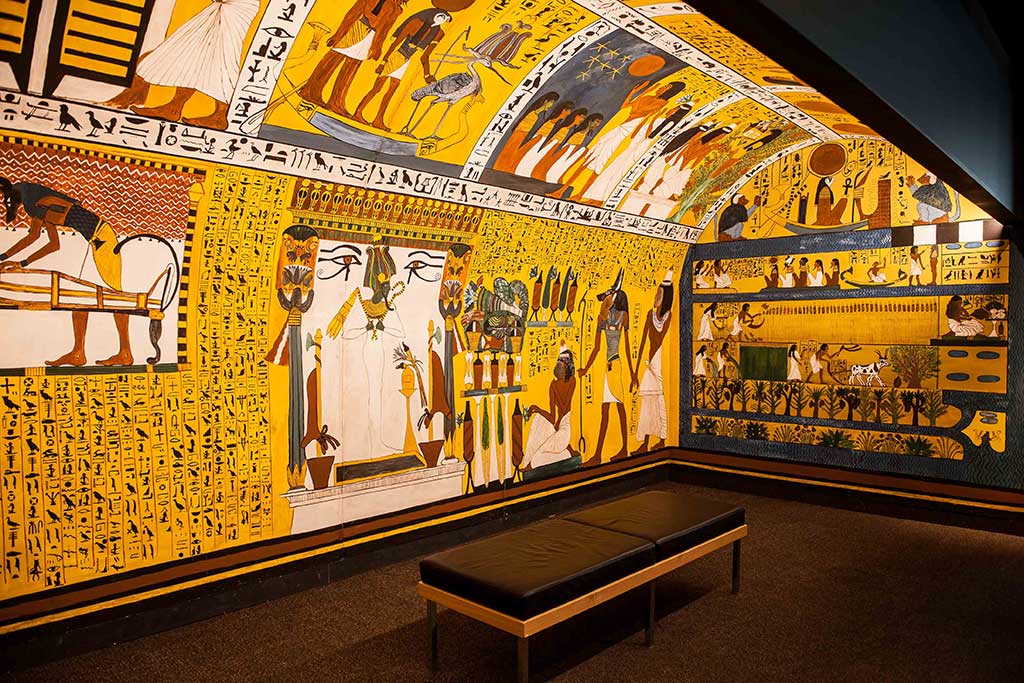
Wandering out of the exhibit, I am again face-to-face with an expansive image of the desert. I watch the sands drift across the Valley of Abydos, renowned for being one of the oldest of the ancient cities in the region and a popular burial spot.
I can almost imagine the gentle “shhhh” of the whispers of the souls rumored to haunt the grounds. While there aren’t any actual voices to hear at the exhibit, I do collect a few words of advice, which are freely dispensed from the mechanical version of the wise Ptahhotep (an ancient vizier who authored a number of sage sayings), to guide me on my journey back in the real world. His words of wisdom were: “Only share what you have seen, not what you have heard.”
Photo credits: The Royal BC Museum

